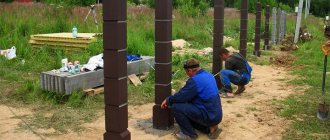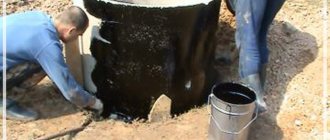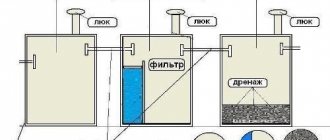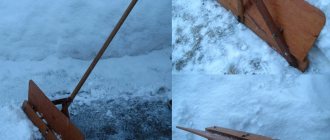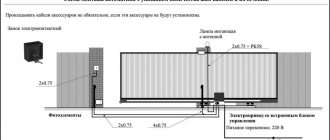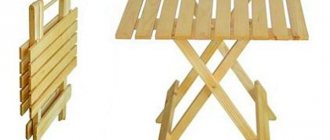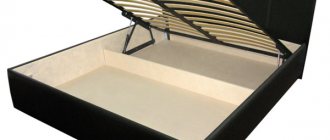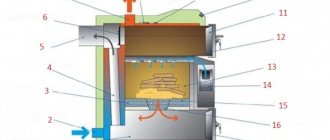A fence is an integral element of a country house or cottage. It is important to choose the right supports to secure the fence structure and make the fence stable. Reinforced concrete is widely used as a material for supports. The increased strength of concrete ensures the reliability and durability of fences. Concrete fence posts are superior in many characteristics to supports made of metal, brick, wood and asbestos. Let's look at the properties of concrete supports and focus on the production of fence posts.
Columnar supports for a fence - types of products and differences in shape
Owners of private houses use various types of material to make fence posts:
- wood. Traditionally, timber with a square or rectangular cross-section, as well as rounded logs, is used. Wooden supports provide an aesthetic perception of the fence. However, they are more expensive and have a limited service life. Wood support elements are used for temporary fencing structures;
- metal. Metal profiles and pipes differ in assortment and cross-sectional shape. Steel supports are characterized by durability and the ability to withstand increased forces. The metal is resistant to natural factors. Metal support posts are used for the construction of various types of fences, which are attached by welding;
Various types of material are used to make fence posts.
- asbestos cement. The material is fragile and susceptible to impact loads. Asbestos-cement pipes require increased care during installation. To increase the strength characteristics of asbestos-cement supports, their internal cavity must be filled with concrete. Asbestos-cement supports are used for various types of fences;
- brick. Fence supports made of annealed brick look presentable. Massive supporting elements ensure the immobility of the structure due to increased strength properties. To ensure the stability of the supports, it is important to know the rules for making brickwork;
- concrete. Concrete fence posts confidently compete with metal profiles and wooden beams. To make supports, it is necessary to use a special concrete solution based on M400 cement. The prepared mixture is poured into a box-shaped formwork in which a metal frame is installed. To improve visual perception, the surface of the concrete pillar is decorated.
Many people install concrete fence posts. In terms of performance characteristics, they are not inferior to, and sometimes even superior to, support elements made from other materials. Supports made of concrete are offered in an expanded range.
They differ:
- cross-sectional shape;
- design option;
- features of fastening sections.
An expanded assortment includes supports made of concrete.
According to the profile configuration, concrete posts correspond to the shape of the following geometric shapes:
- circle;
- square;
- triangle;
- rectangle;
- polyhedron.
By design, columnar supports are divided into the following types:
- monolithic products. They are distinguished by an increased margin of safety and are able to maintain integrity under the influence of significant loads. Used for installation of massive fencing. Solid racks are cheaper than prefabricated elements;
- composite supports. They consist of a concrete mass, inside of which there is a metal base. Decorative elements of various colors and textures are attached to the outer part of the pillar. Prefabricated supports are inferior in strength characteristics to monolithic ones.
Fence sections are connected to pillars using various methods:
- using grooves located parallel to the axis of the support. The groove fastening allows the installation of concrete sections of the fence to be carried out at an accelerated pace;
- by fastening to embedded wood elements. Wooden inserts that function as embedded elements allow you to securely fasten wooden fences;
- by fixation by welding to metal hinges. Metal fasteners in the form of loops are used to fix forged sections of the fence, as well as fences made of corrugated sheets or polycarbonate.
It doesn’t matter how the fence sections are attached. It is important how strong and durable the entire fencing structure will be after installation.
Fence sections are connected to posts using various methods
Types of concreting
When a fence, even from the simplest materials, rests on a solid foundation, it always looks dignified and presentable. Let's look at the most common technologies for concreting fence posts.
Partial concreting
This method is used when performing work on stable soils and under low loads. The essence of the method is as follows:
Sometimes the second method of partial concreting is used, in which the solution is poured into the lower part of the pit, and the top is covered with crushed stone or gravel with careful compaction.
If the presence of a ground part of the foundation is implied, then before concreting the fence post, it is necessary to install formwork for a kind of plinth.
Spot concreting
Dry concreting of pillars
Full concreting
This method is used not only when working with asbestos-cement pipes. It can be used as a basis for installing metal, profile or concrete racks.
Concrete fence posts - advantages and disadvantages of supporting elements
Concrete pillars have many advantages and have proven themselves in the construction of various types of fencing structures:
- concrete fences;
- chain-link fences;
- forged gratings;
- sections made of metal profiles.
Experts speak positively about the characteristics of concrete supports and note their advantages:
- increased safety margin. Concrete reinforced with a reinforcing mesh is able to withstand impacts and the weight of the fence, while maintaining the integrity of the structure;
- ability to withstand long cycles of deep freezing followed by thawing. Temperature changes do not have a negative effect on the supports;
- resistance to precipitation. Thanks to the introduction of special additives into the composition, reinforced concrete pillars have increased moisture resistance;
- constructive simplicity. Supporting elements representing a prefabricated structure made of concrete and steel reinforcement are easy to manufacture in industrial and domestic conditions;
- affordable price. Reinforced concrete fence posts, which are much cheaper than metal and wooden supports, allow you to save money when constructing a fence;
- manufacturability of production. Simple and affordable technology allows you to quickly master the production of supports of various shapes and sizes without the involvement of specialists;
Concrete pillars have many advantages
- long service life. Provided that the manufacturing technology of concrete pillars is followed and hydrophobic additives are used, the service life of the supports is practically unlimited;
- fire resistance. Supporting elements made of reinforced concrete are fireproof products that are superior in fire resistance to pillars and beams made of wood;
- resistance to chemically aggressive environments and the development of microorganisms. Concrete is not destroyed by alkalis and acids. The material is characterized by increased biological resistance;
- corrosion resistance. Provided a fixed distance from the reinforcement grid to the concrete surface is maintained, reinforced concrete pillars are not subject to corrosion damage;
- reduced operating costs. To maintain reinforced concrete supports in proper form, virtually no additional costs are required.
Along with the advantages, it is also necessary to note the weaknesses:
- increased mass. Without additional help, it is problematic to independently carry out all the activities for installing supports;
- labor intensity of production. To make supports, you should prepare group formwork or make many standard forms;
- production duration. Finished supports gain operational strength within a month;
- problematic build-up. The design features of the products do not allow increasing their length by connecting individual elements;
- dependence of product quality on compliance with technological requirements. Changing the formulation affects the durability, appearance and quality of the supports.
Despite a number of disadvantages, concrete supports are widely used for the construction of fences.
Weaknesses also need to be noted in concrete pillars
Self-standing fences
Sketch of a free-standing fencing panel
And, in conclusion, it is impossible not to mention another type of “fast” concrete structures - a fence made of concrete sections. Each section is a solid reinforced concrete slab, standing either on a wide stand or in special “glasses”. The surface of the slab can be smooth or have any relief pattern.
The main advantage of a fence made of concrete sections is that there is no need for a foundation. All that is needed in this case for installation is a flat, well-compacted area. But, unfortunately, too high weight and large dimensions cause difficulties in transportation and installation. Such sections cannot be made by hand.
Sectional fences are most often used in industrial construction. Also widely used as temporary fencing around a house with a large adjacent area.
Concrete fence posts - main characteristics of supports
When planning to make and use concrete fence posts, pay attention to their characteristics:
- strength properties;
- dimensions;
- fire safety;
- durability;
- frost resistance;
- price;
- versatility.
Also analyze the method of attaching the fence sections to the supports and study the manufacturing technology. Let us dwell in more detail on the features of manufacturing technology and installation specifics.
Main Dimensions
The length of factory posts ranges from 1.7 to 4.2 m, which allows you to select the height of the supports taking into account the purpose of the fence. The minimum cross-section is from 13*13 cm and above.
Photo: size guide and various shapes of reinforced concrete pillars from the manufacturer
Kawabang!
Construction of a concrete pool bowl If the list of products does not contain sizes suitable for you, you can place an individual order.
How concrete posts are made and installed
The process of making pillars is carried out using various methods:
- by pouring concrete on a separate site into horizontally located reusable forms. Finished products are removed from the formwork after hardening and installed according to the developed sketch;
- by filling vertically installed forms of the required profile with concrete mixture. Formwork structures are mounted in a vertical position along the perimeter of the fence at the installation site.
The process of manufacturing pillars is carried out using various methods.
Regardless of the specifics of manufacturing, the technology involves the following steps:
- Assembly of the formwork structure.
- Manufacturing of power grid.
- Preparation of cement mortar.
- Pouring concrete mixture into molds.
Depending on the chosen technology, the finished product is removed from the formwork or the formwork elements are dismantled, subject to concreting directly at the installation site.
Giving preference to the preliminary production of supports, carry out installation work according to the following algorithm:
- Plan the perimeter and mark the coordinates for installing the pillars.
- Remove the soil, ensure the walls of the pits are vertical and compact the base.
- Fill the pits with crushed stone-sand cushion, compact the mixture of sand and crushed stone.
After performing these operations, the following remains:
- Fix the support in a vertical position.
- Seal the surface of the well with polyethylene or roofing felt.
- Prepare a concrete mixture and pour it into the cavity.
Having completed concreting, adjust the position of the pillars within half an hour after pouring. Each stage of work has its own characteristics. Let us dwell in more detail on the specifics of performing the main stages.
Each stage of work has its own characteristics
Site preparation and marking for installation of concrete fence posts
At the preparatory stage, a number of works should be performed:
- Clear the surface around the perimeter of the fence from large stones.
- Remove bushes and small vegetation with their roots.
- Level the soil surface.
The marking process is quite simple:
- Drive the outer pegs into the soil.
- Pull the cord for orientation.
- Drive in the remaining stakes at the specified pitch.
Having completed the preparation, remove the soil and prepare pits of the required depth.
Preparing the base for concrete pillars
To ensure the stability of the supports, prepare an acceptance base that serves as a foundation.
To do this you need:
- Level the bottom of the pit.
- Mix sand with gravel.
- Pour the mixture into the bottom.
- Level the surface of the bedding.
All that remains is to thoroughly compact the array by pouring water.
The installation of monolithic support posts for a fence consists of several successive stages
How to choose the location of the formwork and install the load-bearing frame
The formwork is assembled from pre-cut blanks. You should pay attention to the location of the formwork:
- When pouring fence supports at the installation site, the formwork is installed vertically. Immobility is ensured by spacers;
- When pre-concreting the pillars, the formwork should be placed horizontally on a solid surface.
It is important to ensure the tightness of the formwork and perform the reinforcement correctly. The power frame consists of the following parts:
- four parallel rods with a cross section of 1.2-1.8 cm;
- transverse rods with a cross section of 0.8-1 cm, fixed in increments of 10-15 cm.
When installing the frame, maintain a distance of 20-25 mm from the reinforcement to the concrete surface.
How fence posts are poured with concrete mortar
Concreting is carried out with a mixture of sand, cement and gravel, taken in a ratio of 2:1:2. Water is added to the required plasticity of the composition.
Pouring racks involves performing the following operations:
- Coating the inside of the formwork with lubricant.
- Placement of reinforcing lattice in the formwork.
- Filling the mold with concrete mixture.
- Product seal.
After hydration is completed, the finished support should be removed for further drying.
How to decorate finished concrete supports
Decorating concrete pillars improves aesthetic perception. Various decoration methods are used:
- cover the concrete with decorative or mosaic plaster;
- apply acrylic or rubber-based protective paints to the material;
- treat concrete pillars with a polyurethane compound;
- the supports are decorated with mosaics or lined with bricks;
- plastic panels are mounted on concrete.
It is important to choose the right type of protective coating and decoration method to increase the strength of the surface and harmoniously combine the supports with the fence sections.
Making molds for concrete fences with your own hands
A novice “builder” who wants to save money and make a concrete fence with his own hands must have the appropriate tools and time.
To make polyurethane forms with your own hands, you will need to purchase this material from a hardware store, and then mount it in the form of the structure you want your fence to look like. To save time, you can buy a ready-made form; it does not differ much in price.
In any case, the existing forms must be prepared for use in order for the fence to be of high quality and durable:
- Before pouring the solution, it should be thoroughly lubricated with machine oil to avoid concrete sticking to its walls.
- Place the concrete fence forms on the vibrating table.
- Pour the solution halfway into the structure and turn on vibration.
- Place reinforcement into the poured mixture in the amount necessary for the strength of the finished section. It depends on its size.
- Add the solution to the very top of the structure without turning off the vibrating table.
- Very carefully smooth the surface of the future concrete block and turn off the vibration.
- Remove the polyurethane mold, carefully take it to a place to dry and turn it over. The finished section is left to dry, and the mold is filled with the next portion of concrete.
As you can see, the DIY polyurethane mold allows you to quickly produce each section due to its rigidity. It can be used for up to 1000 fills, enough for the largest area.
To ensure that the production of the fence does not take much time, you should think in advance about a dryer, which can be simple shelving under a canopy.
In this case, concrete forms will dry quickly.
Butting with crushed stone
The use of this method is quite justified when the site has heavy soil. This operation is also called “dry concreting”.
- A hole is drilled;
- The support is installed;
- The remaining space is filled with crushed stone;
- The surface is compacted, for which a vibrating plate is used.
As a result, the liquid will freely go into the soil, seeping through the crushed stone. The stability of the pillar increases significantly due to the fact that water in winter does not linger inside the pit, but seeps through the crushed stone layer. It goes away completely, the supports remain in place and the liquid does not push them out.
This method can be used to install any fence, on any soil. When the fence structure has a large mass, the support is installed to a depth that should exceed one meter. In this way, you can successfully concrete fences made of wood.
Design Features
Each fence consists of posts and sections, which can be combined in a variety of variations. Stacked pillars, as the name implies, are structures created from sections installed on top of each other and secured using locking structures or cement mortar. The height of the pillars depends on the number of sections, which have a hollow structure from the inside and are usually installed on vertical metal elements that give strength to the entire structure. The space between the metal center and the sectional structure itself is filled with concrete. Thus, the element performs the functions of permanent formwork, as well as a decorative part, which can have a very different design (the surface can imitate brick, natural stone, slate and other surfaces).
More about plastic
One of the materials used in the manufacture of fence forms is worth special attention - this is plastic.
Advantages
When we talk about plastic, we mean the following invaluable advantages:
Greater strength is thanks to modern production technologies, although initially, it was precisely problems with strength that did not allow plastic to enter the wide “construction” road.
Cheapness. Where there is plastic, there is casting, which means ready-made and mass-produced technologies
This is especially important for the production of fences. when the forms for fence posts and the spans between them already form a single whole, which directly comes out of the press in production.
The shapes of the fences seem to be specially made for use on industrial sites, where the speed of construction comes to the fore, although the design side of the matter is not forgotten
- Ease. which does not at all contradict reliability. But the installation speed increases by an order of magnitude.
- Extreme resistance to negative environmental influences. This feature of modern plastic has been tested in pipes and does not need any proof.
- Huge selection of design solutions. This is also the merit of the very process of producing plastic structures - casting, which is accompanied by the addition of all kinds of additives and dyes, creating an incredible range of colors at the output.
Disadvantages of plastic
Strictly speaking, plastic fence structures have no disadvantages.
More precisely, their advantages are also a continuation of their disadvantages (although, rather, on the contrary).
Ease. But, firstly, plastic is often framed in a rigid metal case, and, secondly, the concept of lightness is very relative for a panel measuring 3 by 2 meters with a thickness of up to 15 cm.
Molds for the production of fences can include all the elements in a single design - then only 2 problems remain to be solved: dimensions and installation
Insufficient reliability. Again, given post structures, any material requires very secure installation of fence posts. The reliability of the entire structure primarily depends on them. But, in addition, no matter what the fence is, it will not withstand the braking of buses on it.
When installing fences in the photo, you cannot do without such a guide as installation instructions; all elements here must be very precisely adjusted to each other
Helpful advice! Installing any fence requires careful attention to post drainage. Keep in mind that the hole for the post should be made 30-40 cm below the freezing level of the soil. If your soil is prone to collecting moisture, so-called heaving, then the best option would be to remove it completely and install the post in a pre-filled mixture of sand and fine gravel. Do not forget to compact this manually prepared soil thoroughly. Drainage must also be carried out at ground level, at a distance of 20-30 cm from the pillar and to a depth of at least 15 cm.
You can even construct a fence from pre-prepared forms. You just need to carefully familiarize yourself with all the options available to you, evaluate all the disadvantages and advantages of each. Be sure to coordinate all proposals with the nature of the soil under your future fence. Most likely, you will entrust the installation of the fence to already experienced craftsmen, but be aware of all the decisions made, then you will not have to regret the choice you made.
It is not necessary that the shape of the fence post must exactly match the shape of its span, the main thing is just to maintain a single style
In the video presented in this article you will find additional information on this topic.
Negative qualities
Such pillars have several characteristic disadvantages. This mainly concerns:
- High cost. The construction of such a structure is very expensive and economically unprofitable;
- Large mass. Such a pole necessarily has a steel pipe inside, which increases the weight of heavy concrete;
- A very complex technological process. Working with concrete requires great care. The slightest failure to comply with the technology will lead to loss of quality and reduced service life; You can forget about reliability.
Return to contents
Preparing the base for installing typesetting blocks
Stacked poles can be installed even by one person. The assembly of stacked pillars is carried out on the basis of a shallow shallow foundation or a separate concrete base for each pillar. As a core for concrete stacked pillars, you can use metal pillars or welded 4 reinforcing rods by 12. For good stability, the support should be buried half the size of its above-ground part.
Filling voids inside the block with concrete.
For this:
- dig a hole larger than the outer size of the block by 15 cm around the entire perimeter. The depth of the hole should be at least two-thirds the depth of the reinforcement.
- A formwork made of boards is placed in the hole.
- For reinforcement, an additional hole with a diameter of 15-20 cm is drilled in the middle.
- The fittings are installed in the pit.
- The voids of the block are filled with concrete, the concrete is pierced several times with a rod to allow the remaining air to escape.
- If a pipe is used as a core, then it is simply driven in with a sledgehammer to the required depth.
- The bottom of the hole is covered with a 5-10 cm layer of gravel or crushed stone and compacted.
- Then the formwork is filled with concrete. The above-ground part of the foundation block is 10-15 cm.
- The foundation hardens for at least 3 days.
Concrete curing process
Laboratory studies have shown that an optimal temperature of 20-30 degrees Celsius is optimal for concrete hardening, with 90% indoor air humidity. Concrete hardening actively occurs in the first 7 days after mixing the solution. Concrete at this time reaches 70% of the calculated hardness.
Concrete reaches 100% strength only 28 days after molding.
Any pillars can be made in this way; you just need to make formwork of the appropriate shape and arm yourself with patience.
Application
The spread of the trend with decorative pillars began several centuries ago, and in order to get a rough idea of architectural traditions, just look at the design of palaces in St. Petersburg or Paris.
The classic combination of metal and stone has been borrowed by modern builders for fencing government buildings and luxury mansions.
Installation at the dacha
The modern construction industry, which has mastered dozens of new materials, has expanded the concept of decorative fence posts. Brick and natural stone remain the classic option for any type of fence.
But concrete, mesh structures with crushed stone, and plastic appeared, which decorate the most primitive options. There are multiple price lists with numerous examples that give an idea of what decorative blocks for fence posts are.
Variety of options
The use of pillars has expanded the scope of demand, but has not limited it, and on modern construction sites you can find many unconventional options for using decorative pillars - from an enclosed atrium and veranda to a large balcony, observation deck, canopy in front of the house, equipped for decorative purposes.
The differentiation of the scope of use of pillars, pillars and columns has led to the need for a targeted choice made taking into account all components.
Fence of a private house
The criteria for selecting the necessary style components were:
- design options and methods of its installation, construction and stability;
- manufacturing material, in which there are possibilities for stylization, replacing natural decorative stone with no less expressive fakes made of plastic;
- durable frame devices, giving the chance to use lighter and cheaper raw materials without loss of visualization and strength;
- dimensions, parameters and configurations to create a unique or standard constant of the same familiar brick fence;
- additional decorative elements (balls and cones, lamps, combinations with metal elements, stucco or its imitation);
- color scheme (contrasting, similar in color perception and tone, combined, imitating geometric or abstract patterns);
- modification of shape (parallelograms, rounded outlines, cones, columns with pedestals or pedestals).
Storage of finished racks
Causes of destruction
Sketch of the correct design of the structure
Often we can see destroyed fences that seemed to have such a strong structure. The whole trouble most often begins with the supporting elements. The supporting part of the fence can collapse for several reasons:
- non-compliance with installation rules, for example, small depth;
- the design of the support element pit does not correspond to the characteristics of the soil;
- the use of low-quality material in the manufacture of a product or in the construction of a foundation.
All such shortcomings will reveal themselves after the first wintering of the structure, so you shouldn’t take risks. It is better to consult with specialists, play it safe several times, than later be disappointed in the fencing structure and regret the money wasted.
Well, if all the work was done efficiently, in compliance with all standards and rules, then such a fencing structure will last for decades, especially if it is provided with decent care.
